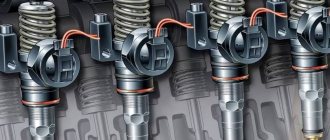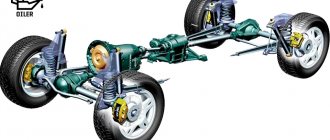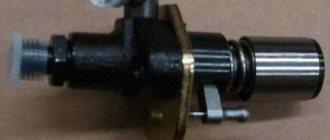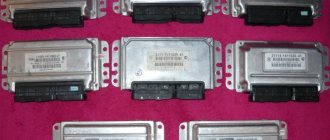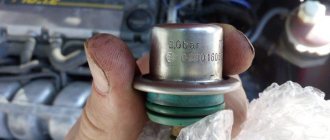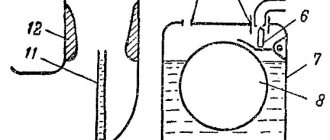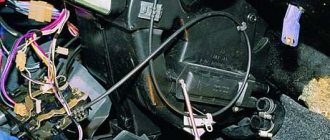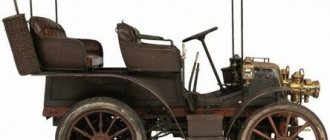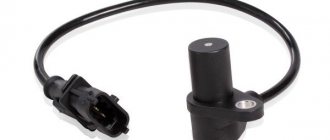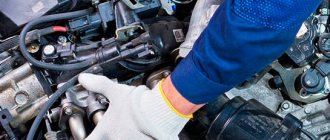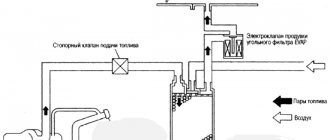The injectors of a diesel engine, as well as an injection engine, periodically become dirty. Therefore, many owners of cars with a diesel engine are wondering - how to check the injectors on a diesel engine? As a rule, if they are clogged, fuel is not supplied to the cylinders in a timely manner, and increased fuel consumption occurs, as well as overheating and destruction of the piston. In addition, burnout of the valves and failure of the particulate filter are possible.
Diesel engine injectors
Adjusting diesel engine injectors
The functions of the injectors are to supply portions of fuel into the cylinder under high pressure, while ensuring its maximum atomization necessary for efficient combustion of the mixture. The operation of these parts is carried out under highly loaded conditions, which contribute to the failure of settings and the occurrence of various malfunctions. In addition, the quality of work gradually deteriorates due to natural wear and tear of moving parts, weakening of springs, jamming of needles, clogging or coking of sprayer holes, etc. Because of this, the injectors of modern diesel engines periodically need to be diagnosed and reconfigured at an adjustment stand.
How to check Bosch Common Rail injectors?
After you lift the hood, the first question that may arise in your mind will be: “Where are the injectors?”
Most modern diesel engines have them hidden under easily removable covers. Remove the cover.
Under the removed cover you will find injectors. They are attached to a line consisting of steel tubes. Disconnect the wire clamps that hold the injector connectors and supply hoses.
Important! They come off very easily, so don't lose them.
Once you have the connectors free, gently pull them up. Here you need to be especially careful, as they are quite fragile and can be broken. Block or pinch the fuel line to prevent fuel leakage (rotate the fastener).
Pre-check
For initial diagnostics of the operation of injectors without removing them from the power unit, a specialized device is used - a maximeter. The design of this type of equipment replicates the design of the nozzle itself. The device is equipped with a micrometric regulator with a scale, the division value of which is 5 MPa, which allows you to adjust the moment when the spray needle begins to rise at levels up to 50 MPa. To carry out the test, the nozzle is connected through a maximeter to the fitting of the discharge section of the pump. Using a micrometer head, the required pressure of the lifting moment of the nozzle needle is adjusted. After this, all other fuel line nuts are loosened and the crankshaft is turned using the starter. In the event that fuel is injected through the diagnosed injector and the maximeter simultaneously, then its setting is recognized as meeting the technical requirements. If fuel flows through the nozzle but does not enter the maximeter, or vice versa, this means that the lift torque pressure is lower or higher than the required value. To adjust the required pressure in the engine injectors, change the degree of spring tightening using the settings screw.
Alternative method
In this case, a pre-adjusted nozzle is used as a reference, using the maximeter principle. The nozzle that requires adjustment is connected to the fuel line through an intermediate tee, to the free outlet of which a reference sample is connected in parallel with the element being diagnosed. After this, the nuts on the remaining fittings are loosened, which makes it possible to interrupt the fuel supply to the remaining injectors, and the decompression mechanism is activated and “full throttle” opens. After fuel is supplied, both nozzles must produce synchronous injection of the mixture. If discrepancies in their operation are detected, the spring pressure on the adjustable nozzle is adjusted, for which the cap is removed from it and the lock nut is loosened. After this, the speed of the calibration screw can be changed. Upon completion of the setup, another comparison is made with the work of the reference sample.
This method is characterized by greater labor intensity compared to using a maximeter.
Comprehensive testing of injectors on a bench
Diagnostics and adjustment of fuel equipment of diesel engines (injectors, injection pumps, etc.) on specialized stands allows you to identify subtle problems and achieve optimal operating conditions for all components and assemblies. Using specialized equipment, the tightness of the nozzles, the pressure level of the lifting moment of the needles, the quality of the torch formation and the cone angle of the supplied fuel jet are checked. The main testing devices for adjusting diesel injectors are devices that test their technical condition and check the hydraulic density of the pump plunger pair.
The design of the diagnostic unit is a manually driven plunger pump designed to supply fuel under controlled pressure, which is monitored using a built-in pressure gauge. This allows you to record the moment and degree of pressure drop.
The quality of the resulting torch when supplying the mixture is monitored visually by the clarity of the beginning and end of the injection phase, as well as by the nature of the exit of fuel jets from the nozzle holes. A correctly working nozzle delivers a portion of the mixture heaped and sharply, with a characteristic accompanying sound. To make the check clearer, a sheet of paper is placed in front of the nozzle, on which, after injection, traces or breakthroughs from the mixture jets remain, the number of which must correspond to the number of holes in the nozzle.
The device for controlling hydraulic density operates on the principle of transmitting a dosed load to the plunger of the discharge section, under the influence of which it enters the sleeve. The speed of movement of the plunger is recorded using a stopwatch and allows you to assess the degree of wear of the entire plunger pair, and, accordingly, its hydraulic density.
Before starting the tests, the device’s own tightness is checked. To do this, a plug is put on the fitting for connecting the nozzle, after which the shut-off valve is opened and a pressure of about 30 MPa is created using a pump. Using a stopwatch, the rate of pressure drop is monitored, which should be within 0.5 MPa/min.
Do-it-yourself washing
First, let's consider the most acceptable option for the car enthusiast: washing the injectors without removing them from the car. To carry out this procedure you will need the following things:
- Wynns flushing fluid;
- empty plastic bottle with a capacity of 1.5 l;
- rubber hose 1.5 m long;
- 2 nipples for car wheels;
- automobile compressor;
- injector filter, 1 piece;
- steel hose clamps, 4 pieces.
Flushing sequence
Before you start washing, you will have to assemble a simple washing device that will work like an IV for the patient.
- The rubber hose is cut into two parts. The end of the first hose mat is put on the ramp fitting. The filter from the injector is connected to the second end of this half.
Injection filter for fine fuel purification, connects to the bottle - A pair of holes are drilled in the cork and bottom of the bottle into which wheel nipples are installed. The nipple is unscrewed from the nipple installed in the bottom, and then the end of the second half of the hose is connected to it. And the other end of this hose is connected to the outlet of the injection filter.
Nipples for car wheels that will be installed in the bottle holes - The result is the design shown in the photo below.
Homemade flushing system for Common Rail injectors made from a bottle - Now you need to open the fuel tank of the car (this is done in order to completely relieve the pressure in the fuel system).
- Flush is poured into the bottle, then a car compressor hose is connected to the nipple in the neck and secured with a clamp.
Wynns injector flushing fluid is the best choice for do-it-yourself flushing - The compressor turns on. The pressure should not exceed 3 atmospheres.
- The car starts and idles until all the flushing fluid is used up.
- When the engine stops, allow it to cool for 30 minutes. After this, the remaining flushing liquid is poured into the bottle, and the whole process is repeated until the engine stops again.
Tightness
For bench testing of tightness in the nozzle, the pressure is slowly raised to 30 MPa using a pump with the adjustment screw turned down. After reaching this indicator, the tightness is checked using the shut-off cone and the guide needle. In addition, possible leaks from the nozzle holes, as well as at the junction of the nozzle and the nozzle body, are monitored. A sudden rapid drop in pressure to 23 MPa or lower indicates a violation of the tightness of the circuit. The permissible reduction time is 17 sec - 45 sec at a temperature of 20 ° C and a kinematic viscosity of the fuel from 3.5 cSt to 6 cSt.
Injection pressure
To determine the pressure to start lifting, several initial injections are made to remove possible air from the system, after which fuel is pumped into the nozzle by slowly pressing the pump lever. The actual pressure threshold is determined by the maximum deviation of the pressure gauge needle at the moment the fuel portion begins to be supplied.
If the actual pressure in a diesel engine differs from the technical standards by more than 0.5 MPa, the degree of tightening of the injector springs is adjusted. If the current indicator exceeds the reference value, the screw is unscrewed, and in the opposite situation, it is tightened. Another customization option is to change the thickness of the gasket to suit the design of the atomizer. After completing the adjustments, it is recommended to make several control injections to check the stability of the equipment. The difference in the values of the moments when the needle begins to rise should also not exceed 0.5 MPa.
Adjusting the injection pump
Adjusting the injection pump at Diesel-Pro in Moscow is excellent quality, affordable cost and a guarantee. We will promptly adjust or repair the fuel injection pump. We will carry out all work professionally in accordance with the requirements of European, Chinese and domestic manufacturers. We will adjust the fuel pump for cars and trucks.
If during the adjustment process you need to replace spare parts, we offer to buy or order any parts from the catalog of our online store at an affordable price. Modern bench equipment, training in foreign auto centers and responsibility for the work performed allow us to efficiently and quickly adjust fuel injection pumps.
Cost for adjustment
| Distribution injection pumps | Price in rub. | ||
| 1 | Dismantling/installation of fuel injection pump | 4 200 | |
| 2 | Diagnostics of fuel injection pumps BOSCH, ZEXEL, DENSO VE | 3 000 | |
| 3 | Diagnostics of injection pump BOSCH, ZEXEL VP, Lucas-Perkins | 6 000 | |
| 4 | Adjusting injection pump BOSCH, ZEXEL, DENSO VE | 2 000 | |
| 5 | Adjusting injection pump BOSCH, ZEXEL VP, Lucas-Perkins | 3 000 | |
| 8 | Diagnostics of injection pump ZEXEL VRZ | 7 500 | |
| 10 | Checking the injector on the stand | 100 | |
| 12 | Adjustment of BOSCH, ZEXEL, DENSO, DELPHI injectors on the stand | 500 | |
| In-line injection pumps | Price in rub. | ||
| 1 | Dismantling/installation of in-line fuel injection pump with ignition installation | 12000 | |
| 2 | Checking the performance of fuel injection pumps Euro 0, Euro 1, Euro 2 on a stand* | 1500 | |
| 3 | Checking the performance of the Euro 3 fuel injection pump on a stand* | 2000 | |
| 4 | Checking the performance of a double-rack Euro 3 H-type fuel injection pump on a stand* | 2500 | |
| 5 | Disassembly - troubleshooting the injection pump with subsequent assembly | 2500 | |
| 6 | Assembly of any injection pump after troubleshooting | 1000 | |
| 7 | Checking the injector on the stand | 100 | |
| 9 | Adjustment on the bench of injectors BOSCH, ZEXEL, DENSO, DELPHI, YAZDA, NZTA, AZPI | 500 | |
The full cost of services can be viewed here.
When to adjust fuel pumps
Repair and adjustment of fuel injection pumps in Moscow, performed at a service center, is a guarantee of safe driving. After a thorough examination of the condition of the fuel system, the technicians will perform all the necessary operations for high-quality adjustment of injection pumps from BOSCH, ZEXEL, DELPHI, DENSO and other manufacturers.
This work is complex and responsible. To implement it, you need high qualifications of the performer and the availability of special high-precision proprietary equipment. It is on such stands and equipment that our auto mechanics, who have undergone foreign training, work.
The stands on which fuel pumps are adjusted in our centers allow us to make adjustments and measurements with high accuracy. Such equipment provides:
- identical feed and stroke values of the plunger pairs;
- correct setting of the speed controller;
- precise adjustment of the injection advance clutch;
- correct operation of the regulator;
- correct setting of the boost corrector.
High-quality fuel injection pump adjustment is cheaper than repairs. As a result, the following parameters return to normal: fuel supply, oil and air pressure, rack travel, exact position of locking elements, etc. This helps reduce fuel consumption and makes driving safer.
Why customers choose Diesel-PRO
We offer favorable prices for the repair of diesel equipment, including adjustment and repair of fuel injection pumps. Vast experience, a responsible approach to business and only high-quality, prompt execution of orders attract our clients.
Such trust is worth a lot. This encourages us to look for ways to reduce the cost of our services, monitor new technologies and implement them in service providers. Scheduled internships abroad, attentive attitude to the client and the introduction of innovative methods for diagnosing, adjusting and repairing fuel pumps are the key to high-quality execution of any orders. Leave a request on the website or call, and we will quickly, affordably and accurately adjust the injection pump of your car.
Fuel atomization quality
Checking the quality of torch formation is carried out on an adjusted nozzle, for which the valve is closed and a portion of fuel is pumped up using a lever. After filling, control injections are made. A satisfactory result is the formation of torches of a mixture of fog-like consistency, which are evenly distributed over the cross section of the nozzle cone without obvious concentrations, drops or jets. In this case, the beginning and end of the injection phase should have clear boundaries without subsequent leakage of fuel from the nozzle and be accompanied by a characteristic ringing cutoff sound. As an option for additional testing, slow injection of fuel by the stand pump is used. In this case, it should be injected in small portions with a clearly audible fractional tapping.
To determine the cone angle, filter paper is installed in front of the nozzle, and calculations are made based on the jet imprints.
In the event that the adjustment of the nozzle on the stand did not allow the specified indicators of the quality of mixture atomization, delivery pressure, tightness, etc. to be achieved. This unit is assessed as faulty and the question of the possibility of its repair is raised.
Wear of fuel equipment, or its partial failure, is not critical, but a very serious problem, since interruptions in the supply of the mixture over time cause breakdowns of other components of the power unit. Despite the fact that if the injectors are clogged or unadjusted, it is still possible to operate the vehicle, all manufacturers recommend repairs as quickly as possible, which will preserve engine performance and avoid subsequent financial costs. Thus, at the first sign of unstable fuel supply, you should contact a service center.
has diagnostic stands and specialized equipment for checking and adjusting the fuel equipment of various types of diesel engines.
Source
Setting up burners for diesel fuel
Liquid fuel boilers are efficient units capable of heating domestic and industrial premises.
Liquid fuel comes in different types: waste oil from various industries, kerosene, diesel fuel, etc.
Types of burners for diesel fuel
A burner is a device that prepares fuel and ignites it in the combustion chamber. Diesel burners are divided according to the principle:
- Fuel combustion: nozzles that atomize fuel into small particles mixed with air, pre-gasification burners and evaporative burners.
- By type of fuel burned: burners for one type of fuel (liquid) and combined burners for two types of fuel (liquid and gaseous).
- According to the operating mode of the burners: single-stage, two-stage and modulating.
Operating principle of the burner
One type of burner is a nozzle that sprays fuel. Its action consists of several stages:
- Fuel supply Fuel is stored in the fuel tank and is transported through fuel lines by a fuel pump.
- Fuel preparation Any fuel becomes contaminated, so a fuel filter is installed before it is supplied to the burner. In this filter, mechanical impurities are cleaned, after which the fuel is sent to a preheating chamber (this is necessary to reduce viscosity). The heating temperature is maintained automatically.
- Fuel combustion The supply of fuel from the heating chamber is carried out according to the injection principle: a strong flow of compressed air creates a vacuum in the fuel pipeline, thereby sucking in the fuel along with it. As a result, the air flow and fuel are mixed and supplied to the nozzle. The nozzle sprays liquid into small droplets, which are evenly distributed throughout the volume of the combustion chamber. A strong flow of compressed air is created by the compressor. Secondary air is supplied using a fan equipped with a damper for regulation.
- Ignition of fuel Liquid fuel is ignited using electrodes or an ignition transformer in automatic mode.
Read about the use of electric boilers in the article.
You can read about universal burners for liquid fuel here -
Also learn about the operating principle, brands and main characteristics of waste oil boiler burners.
Burner operating modes
Most burners are equipped with an automatic control unit that monitors the safe operation of the equipment and temperature regulation.
The burner operating mode can be:
- Single-stage (burner operates at 100% of its power). To regulate the temperature of the coolant, the burner is constantly turned on and off.
- The two-stage mode allows the burner to operate at 40% of its total power and at 100%.
- The two-stage intermediate mode smoothly switches between 40 and 100% burner power.
- The modulated burner operating mode regulates the coolant temperature by smoothly switching power in the range from 10 to 100% of the total power.
Burner selection and installation
When choosing a diesel burner, pay attention to the following characteristics:
- Type of fuel burned.
- Thermal power.
- Fuel consumption.
- Operating mode.
- Dimensions and weight.
- Power consumption.
- Manufacturer's passport requirements.
Checking diesel injectors
Injector performance calculator
Online injector performance calculator
The injectors of a diesel engine, as well as an injection engine, periodically become dirty. Therefore, many owners of cars with a diesel engine are wondering - how to check the injectors on a diesel engine? As a rule, if they are clogged, fuel is not supplied to the cylinders in a timely manner, and increased fuel consumption occurs, as well as overheating and destruction of the piston. In addition, burnout of the valves and failure of the particulate filter are possible.
Diesel engine injectors
Checking diesel injectors at home
Common Rail fuel systems (with a common rail) and pump injectors (where each cylinder is separately supplied with its own injector) can be used.
They are both capable of ensuring high environmental friendliness and engine efficiency. Since these diesel systems function and are designed in a similar way, but Common Rail is more progressive in terms of efficiency and noise level, although it loses in power, and has become increasingly used on passenger cars, we will talk about it further. And we’ll talk about the operation, malfunctions and testing of pump injectors separately, because this is an equally interesting topic, especially for owners of VAG group cars, since software diagnostics are quite easy to perform there.
Causes and methods of eliminating fuel leaks from a fuel injector
The diesel system is checked for leaks as follows:
- the nozzle, the place where it is screwed in and the nut securing the tube are wiped dry;
- the designated areas are wiped with chalk;
- the engine starts and immediately turns off;
- there will be a leak in the place where the chalk has darkened.
As a rule, it leaks from under the fuel pipe. In this case, replacing it will help. If the injector is sweating, then it is thoroughly checked, and if there is a place between the injection element and the head, the copper o-ring must be replaced.
There are several reasons for diesel leakage from the nozzle. The most common one is the loosening of the washer located under the problematic injection element. You need to replace it and check the entire system again.
Checking diesel injectors for overflow (drain to return)
Checking the volume of return flow
As diesel injectors wear out over time, a problem arises due to the fact that the fuel from them gets back into the system, due to which the pump cannot generate the required operating pressure. The consequence of this may be problems with starting and operating the diesel engine.
Before the test, you will need to buy a 20 ml medical syringe and an IV system (to connect the syringe you will need a 45 cm long tube). To find an injector that throws more fuel into the return line than it should, you need to use the following algorithm:
- remove the plunger from the syringe;
- with the engine running, use the system to connect the syringe to the “return” of the injector (insert the tube into the neck of the syringe);
- hold the syringe for two minutes so that fuel is drawn into it (provided that it will be filled);
- repeat the procedure one by one for all nozzles or build a system for all of them at once.
Based on information about the amount of fuel in the syringe, the following conclusions can be drawn:
Checking the return flow
- if the syringe is empty, it means the nozzle is fully operational;
- the amount of fuel in a syringe with a volume of 2 to 4 ml is also within normal limits;
- if the volume of fuel in the syringe exceeds 10.15 ml, this means that the injector is partially or completely out of order and needs to be replaced/repaired (if it pours 20 ml, then it is useless to repair, since this indicates wear of the injector valve seat ), since it does not maintain fuel pressure.
However, such a simple check without a hydraulic stand and plan test does not give a complete picture. Indeed, in fact, when the engine is running, the amount of fuel discharged depends on many factors; it can be clogged and needs to be cleaned, or it freezes and needs to be repaired or replaced. Therefore, this method of checking diesel injectors at home allows you to only judge their throughput capabilities. Ideally, the amount of fuel volume they pass through should be the same and range up to 4 ml in 2 minutes.
To ensure that the injectors last as long as possible, refuel with high-quality diesel fuel. After all, it directly depends on the operation of the entire system. In addition, install original fuel filters and do not forget to change them on time.
Diesel Fuel Equipment Repair Forum
Antonch User
On the forum: 2 years and 1 month and 9 days Messages: 15 Registered: 25 Sep 2022, 16:30 City: Chelyabinsk Contact information:
Adjusting the nozzle bosch 0445120161
- Quote
Post by Antonch » 13 Aug 2022, 16:37
Pavel_volg Advanced user
On the forum: 2 years and 1 month and 9 days Messages: 85 Registered: 25 Sep 2022, 16:45 City: Volgograd Thanked: 4 times Thanked: 4 times Contact information:
Adjusting the nozzle bosch 0445120161
- Quote
Post by Pavel_volg » 13 Aug 2022, 20:23
DimDizel Advanced user
On the forum: 2 years and 1 month and 5 days Messages: 99 Registered: Sep 29, 2022, 17:14 City: Nizhny Novgorod Thanked: 54 times Thanked: 25 times Contact information:
Adjusting the nozzle bosch 0445120161
- Quote
Post by DimDiesel » Aug 13, 2022, 10:26 pm
Lexey71 Advanced user
On the forum: 2 years and 7 months and 30 days Messages: 191 Registered: March 04, 2022, 12:44 City: Donskoy Thanked: 12 times Thanked: 50 times Contact information:
Adjusting the nozzle bosch 0445120161
- Quote
Post by Lexey71 » 14 Aug 2022, 07:38
tivalik6 Veteran
On the forum: 2 years and 8 months and 9 days Messages: 1291 Registered: 25 Feb 2022, 13:07 City: Tikhoretsk Thanked: 131 times Thanked: 130 times Contact information:
Adjusting the nozzle bosch 0445120161
- Quote
Post by tivalik6 » Aug 14, 2022, 12:44 pm
Lexey71 Advanced user
On the forum: 2 years and 7 months and 30 days Messages: 191 Registered: March 04, 2022, 12:44 City: Donskoy Thanked: 12 times Thanked: 50 times Contact information:
Adjusting the nozzle bosch 0445120161
- Quote
Post by Lexey71 » Aug 14, 2022, 1:05 pm
tivalik6 Veteran
On the forum: 2 years and 8 months and 9 days Messages: 1291 Registered: 25 Feb 2022, 13:07 City: Tikhoretsk Thanked: 131 times Thanked: 130 times Contact information:
Adjusting the nozzle bosch 0445120161
- Quote
Post by tivalik6 » Aug 14, 2022, 1:33 pm
Ok, then so. Where is it written that I am adjusting it? Why distort it? You can measure it before assembly, so as not to guess later where the jamb is.
Dim Diesel wrote that if the injector parameters do not fit into the test plan (and I think that he did not mean the ability to adjust VE.), then the magnet must be replaced. Where is this from?
I am writing this for the second time. If you measure the excess stroke directly, then it should be 0.047-0.015 by step. If you measure it using another method as DimDiesel measures or suggests, then 0.047 armature stroke + 0.047 residual armature stroke = 0.094 (+)(-) 0.015 tolerance = 0.109 Where is the nonsense here?
soon Global moderator
On the forum: 2 years and 8 months and 18 days Messages: 3088 Registered: 16 Feb 2022, 21:05 City: Belarus. Mogilev Thanked: 892 times Thanked: 635 times Contact information:
Adjusting the nozzle bosch 0445120161
- Quote
Message soon » 14 Aug 2022, 21:25
Antonch User
On the forum: 2 years and 1 month and 9 days Messages: 15 Registered: 25 Sep 2022, 16:30 City: Chelyabinsk Contact information:
Adjusting the nozzle bosch 0445120161
- Quote
Post by Antonch » Aug 14, 2022, 10:44 pm
DimDizel Advanced user
On the forum: 2 years and 1 month and 5 days Messages: 99 Registered: Sep 29, 2022, 17:14 City: Nizhny Novgorod Thanked: 54 times Thanked: 25 times Contact information:
Adjusting the nozzle bosch 0445120161
- Quote
Post by DimDiesel » 16 Aug 2022, 18:32
Yes, with ANE he made a mistake of 0.047, not 0.050 (I didn’t have the program at hand) and the redundant one was correspondingly less than 0.047 (this is data from step 25-2, I hope there is no need to back it up with a file - we have trust). But, step by step - in the courses that I took (not those organized by the authors of the site), not a word was said about the composition of the CRin2-3 unit, and they are my main ones coming for repairs. Therefore, I had to figure out everything by hand, and I didn’t have a step program at that time. On working injectors installed on a car from the factory (without intervention), the dimensions of the residual stroke (down) are equal to the dimensions of ANE (data from a good dozen CRIN 2-3 injectors). The residual data - 0.010 -0.030 occurs during installation, but this is a gag (not in a bad sense) of an individual specialist that is passed on to students in science. I strongly disagree with the idea that you shouldn’t get involved in the residual. This is the related part of the adjustment.
Checking injectors using special instruments
A more serious check of diesel engine injectors is carried out using a device called a maximeter . This name refers to a special model nozzle with a spring and scale. With their help, the pressure at the start of diesel fuel injection is set.
Another verification method is to use a control model working injector , with which the devices used in the engine are compared. All diagnostics are performed with the engine running. The algorithm of actions is as follows:
- dismantle the injector and fuel line from the engine;
- a tee is connected to the free fitting of the fuel injection pump;
- loosen the union nuts on other fuel injection pump fittings (this will allow fuel to flow to only one injector);
- the control and tested nozzles are connected to the tee;
- activate the decompression mechanism;
- rotate the crankshaft.
Cleaning (rinsing) instructions
As mentioned above, a common problem with diesel injectors is their clogging. To restore the performance of the injection elements, cleaning is carried out.
It can be done in two ways:
- without dismantling the injectors;
- with removal.
In the first case, a special additive is added to the fuel, which can clean the injector of deposits. However, this method rarely gives results, especially for diesel cars. Solvent cleaning is much more effective. But here you have to build a small autonomous system from a fuel filter, bottles, pressure gauge and compressor. This work requires caution, as the pressure must be constantly monitored, otherwise the plastic bottles will burst.
As for complete cleaning, it is only possible by removing the injectors from the engine.
Elements can be washed using:
- ultrasound;
- chemical composition.
Ultrasonic cleaning is more effective, but requires a special stand. In addition, this option has its drawbacks: this washing option is contraindicated for some types of nozzles.
Chemical processing is much simpler. As a rule, carb cleaner is used. It connects to your phone charger. Then a small circuit is constructed and the injection system is simultaneously flushed. Using a carburetor cleaner, you can wash out medium-hard deposits. However, it cannot remove fossils and old deposits: ultrasound must be used here.
Cleaning diesel injectors
You can clean diesel engine injectors yourself. Work must be carried out cleanly and in good lighting. To do this, the injectors are removed and washed either in kerosene or in diesel fuel without impurities. Before reassembling, you need to blow off the nozzle with compressed air.
It is also important to check the quality of fuel atomization, that is, the shape of the injector “torch”. There are special techniques for this. First of all, you need a test bench. There they connect the injector, supply fuel to it and look at the shape and strength of the jet. Often, a blank sheet of paper is used for testing, which is placed under it. Traces of fuel ingress, the shape of the torch and other parameters will be clearly visible on the sheet. Based on this information, it will be possible to make the necessary adjustments in the future. A thin steel wire is sometimes used to clean the nozzle. Its diameter should be at least 0.1 mm smaller than the diameter of the nozzle itself.
Diesel fuel spray quality
A normally operating injector, at the moment of fuel supply, produces a single, short and “heaped” injection, which is accompanied by a sharp sound. A common situation is that the injector (spray) nozzle holes may be partially clogged or worn out. Then the nozzle requires cleaning or replacement.
We recommend reading the article on how to choose the right oil for a diesel engine. From this article you will learn about the main parameters and criteria when choosing diesel engine oil, taking into account the individual characteristics and operating conditions of the engine.
In this case, the part must be mounted on a testing stand and directed with the nozzle to a specially prepared place. You need to put clean paper in this place in order to simplify the diagnostic process. Next, sharp fuel injection is carried out. After this, you can see on the paper traces or breaks in the sheet from the jets of diesel fuel. The total number of such marks after injection should be identical to the total number of holes in the nozzle structure. If there are fewer marks on the paper, then some of the holes are clogged and the diesel injector nozzle (spray) needs to be cleaned.
Traces of diesel fuel on the paper should have the same density, and also be located at an equal distance from the center. An important function of the injector is not only supply, but also ensuring the most uniform spray of diesel fuel around the circumference.
The holes are cleaned after disassembling the injector. Cleaning without disassembling the element is not recommended due to the fact that dirt and deposits will remain inside. The sprayer and other parts must be thoroughly washed in kerosene. The resulting carbon deposits, which are located on the outside of the component elements, are carefully removed with a wooden scraper. The holes themselves are cleaned with a small piece of thin and soft steel wire.
Please note that the diameter of the wire must be at least 0.1 mm smaller than the diameter of the nozzle holes. If the nozzle holes increase their total cross-section or the correct shape of the holes is disrupted, this will lead to a decrease in the rate of fuel exit from the nozzle. The spray quality will automatically deteriorate.
The nozzle must be replaced if the diameter of the nozzle holes is increased by only 10% of the maximum allowable. Another reason for replacing the nozzle is a 5% difference in hole diameters. After cleaning or replacing the nozzle, the nozzle is reassembled.
Possible malfunctions of diesel injectors
The most common cause of malfunction is a malfunction of the needle in the nozzle guide sleeve. If its value is reduced, then a large amount of fuel flows through the new gap. In particular, for a new injector, a leak of no more than 4% of the working fuel that enters the cylinder is allowed. In general, the amount of fuel from the injectors should be the same. You can detect a fuel leak at the injector as follows:
- find information about what pressure should be when opening the needle in the injector (it will be different for each engine);
- remove the nozzle and install it on the test bench;
- create obviously high pressure on the nozzle;
- Using a stopwatch, measure the time after which the pressure drops by 50 kgf/cm2 (50 atmospheres) from the recommended value.
Checking the injector on the stand
This time is also specified in the technical documentation for the engine. Typically for new injectors it is 15 seconds or more. If the nozzle is worn, this time can be reduced to 5 seconds. If the time is less than 5 seconds, then the injector is already inoperative. You can read additional information on how to repair diesel injectors (replace nozzles) in the additional material.
If the injector valve seat is worn out (it does not hold the required pressure and excessive drainage occurs), repairs are useless and will cost more than half the cost of a new one (which is about 10 thousand rubles).
Sometimes a diesel injector may leak a small or heavy amount of fuel. And if in the second case only repairs and a complete replacement of the nozzle are necessary, then in the first case you can do it yourself. In particular, it is necessary to grind the needle to the seat. After all, the main reason for leakage is a violation of the seal at the end of the needle (another name is a sealing cone).
To remove leaks from a diesel injector, thin GOI grinding paste is often used, which is diluted with kerosene. During lapping, it is necessary to ensure that the paste does not get into the gap between the needle and the bushing. At the end of the work, all elements are washed in kerosene or diesel fuel without impurities. After this, you need to blow them with compressed air from the compressor. After assembly, check again for leaks.
conclusions
Partially failed injectors are not critical, but a very unpleasant breakdown . After all, their incorrect operation leads to a significant load on other components of the power unit. In general, the machine can be operated with clogged or misconfigured injectors, but it is advisable to carry out repairs as quickly as possible. This will keep your car engine in working condition, which will save you from even greater financial expenses. So, when the first symptoms of unstable operation of the injectors on your diesel car appear, we recommend that you at least check the functionality of the injector in an elementary way, which, as you can see, anyone can do at home.
Source
Table: performance of Bosch injectors
| Injector marking | Performance | Nominal pressure | |
| cm³/min | grams/min | ||
| 0-280-150-001 | 264.9 | 190.5 | 3.0 |
| 0-280-150-002 | 264.9 | 190.5 | 3.0 |
| 0-280-150-003 | 379.9 | 273.3 | 3.0 |
| 0-280-150-007 | 264.9 | 190.5 | 3.0 |
| 0-280-150-008 | 264.9 | 190.5 | 3.0 |
| 0-280-150-009 | 264.9 | 190.5 | 3.0 |
| 0-280-150-015 | 379.9 | 273.3 | 3.0 |
| 0-280-150-023 | 352.1 | 253.3 | 3.0 |
| 0-280-150-024 | 379.9 | 273.3 | 3.0 |
| 0-280-150-026 | 379.9 | 273.3 | 3.0 |
| 0-280-150-035 | 320.6 | 230.6 | 2.0 |
| 0-280-150-036 | 379.9 | 273.3 | 3.0 |
| 0-280-150-041 | 480.3 | 345.5 | 3.0 |
| 0-280-150-043 | 379.9 | 273.3 | 3.0 |
| 0-280-150-044 | 337.9 | 243 | — |
| 0-280-150-045 | 400.4 | 288 | — |
| 0-280-150-100 | 185 | 133.1 | 3.0 |
| 0-280-150-105 | 190.2 | 136.8 | 3.0 |
| 0-280-150-112 | 190.2 | 136.8 | — |
| 0-280-150-114 | 190.2 | 136.8 | — |
| 0-280-150-116 | 190.2 | 136.8 | — |
| 0-280-150-117 | 190.2 | 136.8 | — |
| 0-280-150-118 | 190.2 | 136.8 | — |
| 0-280-150-119 | 190.2 | 136.8 | — |
| 0-280-150-121 | 178.1 | 128.1 | 3.0 |
| 0-280-150-123 | 191.3 | 137.6 | — |
| 0-280-150-125 | 192 | 138.1 | 3.0 |
| 0-280-150-126 | 192 | 138.1 | 3.0 |
| 0-280-150-128 | 167.1 | 120.2 | 3.0 |
| 0-280-150-129 | 191.3 | 137.6 | — |
| 0-280-150-130 | 192 | 138.1 | 3.0 |
| 0-280-150-133 | 191.3 | 137.6 | — |
| 0-280-150-135 | — | 147.4 | 3.0 |
| 0-280-150-136 | 191.3 | 137.6 | — |
| 0-280-150-150 | 190.2 | 136.8 | 3.0 |
| 0-280-150-151 | 240.7 | 173.1 | 2.0 |
| 0-280-150-151 | 304.8 | 219.2 | 3.0 |
| 0-280-150-152 | 236.5 | 170.1 | — |
| 0-280-150-153 | 236.5 | 170.1 | 3.0 |
| 0-280-150-154 | 236.5 | 170.1 | 3.0 |
| 0-280-150-157 | 214.4 | 154.2 | 2.5 |
| 0-280-150-157 | 239.9 | 172.6 | 3.0 |
| 0-280-150-158 | 239.9 | 172.6 | 3.0 |
| 0-280-150-159 | 255.9 | 184.1 | — |
| 0-280-150-160 | 199.7 | 143.6 | 3.0 |
| 0-280-150-161 | 180.8 | 130 | 3.0 |
| 0-280-150-162 | 180.8 | 130 | 3.0 |
| 0-280-150-163 | 180.8 | 130 | 3.0 |
| 0-280-150-164 | 180.8 | 130 | 3.0 |
| 0-280-150-165 | 233.3 | 167.8 | 3.0 |
| 0-280-150-166 | 213.4 | 153.5 | 3.0 |
| 0-280-150-166 | — | 185.7 | 3.0 |
| 0-280-150-200 | 300.6 | 216.2 | 3.0 |
| 0-280-150-201 | 236 | — | 3.0 |
| 0-280-150-203 | 185 | 133.1 | 2.5 |
| 0-280-150-204 | 168.2 | 121 | 2.5 |
| 0-280-150-205 | 170.3 | 122.5 | 2.5 |
| 0-280-150-206 | 168.2 | 121 | 2.5 |
| 0-280-150-207 | 171.3 | 123.2 | 2.5 |
| 0-280-150-208 | 144 | 103.6 | 2.7 |
| 0-280-150-209 | 168.2 | 121 | 2.5 |
| 0-280-150-210 | 135.1 | 97.19 | 2.5 |
| 0-280-150-211 | 147.6 | 106.1 | 3.0 |
| 0-280-150-213 | 346.8 | 249.5 | 3.0 |
| 0-280-150-214 | 188.1 | 135.3 | 3.0 |
| 0-280-150-215 | 214.4 | 154.2 | 2.5 |
| 0-280-150-215 | — | 187.3 | 3.0 |
| 0-280-150-216 | 214.4 | 154.2 | 2.5 |
| 0-280-150-217 | 168.2 | 121 | 2.5 |
| 0-280-150-218 | 312.1 | 224.5 | 3.1 |
| 0-280-150-219 | 168.2 | 121 | 2.5 |
| 0-280-150-220 | 148.2 | 106.6 | 3.0 |
| 0-280-150-221 | 148.2 | 106.6 | 3.0 |
| 0-280-150-222 | 168.2 | 121 | 2.5 |
| 0-280-150-223 | 224.4 | 161.4 | 2.48 |
| 0-280-150-226 | 190.2 | 136.8 | 3.0 |
| 0-280-150-227 | 190.2 | 136.8 | 3.0 |
| 0-280-150-230 | 183.9 | 132.3 | — |
| 0-280-150-231 | 148.2 | 106.6 | — |
| 0-280-150-233 | 148.2 | 106.6 | — |
| 0-280-150-234 | 190.2 | 136.8 | 3.0 |
| 0-280-150-235 | 190.2 | 136.8 | 3.0 |
| 0-280-150-237 | 152.9 | 110 | 3.0 |
| 0-280-150-238 | 190.2 | 136.8 | 3.0 |
| 0-280-150-239 | 224.4 | 161.4 | 2.48 |
| 0-280-150-252 | 260.1 | 187.1 | — |
| 0-280-150-254 | 260.1 | 187.1 | 2.5 |
| 0-280-150-255 | 255.9 | 184.1 | — |
| 0-280-150-257 | 190.2 | 136.8 | 3.0 |
| 0-280-150-300 | 190.2 | 136.8 | 3.0 |
| 0-280-150-302 | 190.2 | 136.8 | 3.0 |
| 0-280-150-303 | 190.2 | 136.8 | 3.0 |
| 0-280-150-306 | 520.2 | 374.2 | 3.0 |
| 0-280-150-309 | 190.2 | 136.8 | 3.0 |
| 0-280-150-310 | 190.2 | 136.8 | 3.0 |
| 0-280-150-314 | 190.2 | 136.8 | 3.0 |
| 0-280-150-315 | 190.2 | 136.8 | 3.0 |
| 0-280-150-318 | 190.2 | 136.8 | 3.0 |
| 0-280-150-319 | 190.2 | 136.8 | 3.0 |
| 0-280-150-320 | 190.2 | 136.8 | 3.0 |
| 0-280-150-321 | 190.2 | 136.8 | 3.0 |
| 0-280-150-322 | 190.2 | 136.8 | 3.0 |
| 0-280-150-323 | 190.2 | 136.8 | 3.0 |
| 0-280-150-324 | 190.2 | 136.8 | 3.0 |
| 0-280-150-325 | 190.2 | 136.8 | 3.0 |
| 0-280-150-326 | 190.2 | 136.8 | 3.0 |
| 0-280-150-327 | 190.2 | 136.8 | 3.0 |
| 0-280-150-334 | 190.2 | 136.8 | 3.0 |
| 0-280-150-335 | 300.6 | 216.2 | 3.0 |
| 0-280-150-351 | 746.2 | 536.8 | 3.0 |
| 0-280-150-352 | 270.1 | 194.3 | 3.0 |
| 0-280-150-355 | 388.9 | 279.7 | — |
| 0-280-150-355 | 300.6 | 216.2 | 3.0 |
| 0-280-150-357 | 300.6 | 216.2 | 3.0 |
| 0-280-150-360 | 270.1 | 194.3 | 3 0 |
If you have any questions, leave them in the comments below the article. We or our visitors will be happy to answer them
